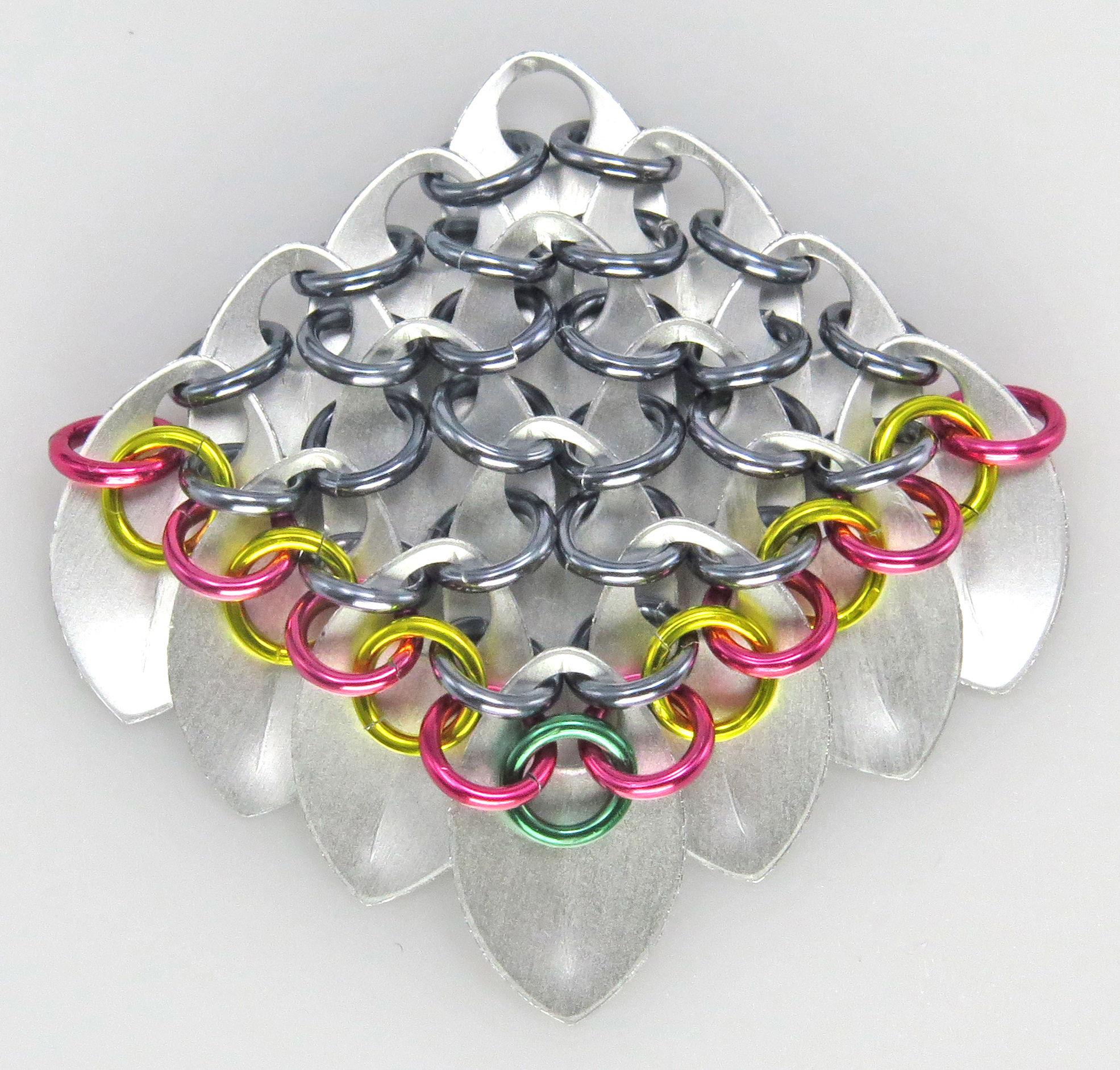Stabilizing the Edges of Scale Maille
When making scale maille pieces, the scales along the edges are often loose and wiggly and need some sort of treatment to keep them neat and even. In scale maille and chain maille, there are usually several ways to accomplish any desired result. Here are the techniques I use to keep my edges under control.
Scale Stabilization Techniques for Pieces with Diagonal Edges:
Diagonal pieces do not have side edges like straight pieces. There is a bottom edge shaped like a V and a top edge shaped like an inverted V. The bottom edge and the top edge each have a left and right side. The center scales on the top and bottom are shared by both the left and right sides.
Left/Right Bottom Edges

1. Add jump rings (pink) to each scale along the bottom edge as shown. Notice that 2 jump rings are added to the center bottom scale.

2. Add stabilizing jump rings (yellow) along the left and right sides of the bottom edge. Each stabilizing jump ring (yellow) passes through 3 jump rings (see blue dots). Follow the weaving paths shown.

3. To finish the bottom edge, weave one jump ring (green) through the 2 jump rings (pink) added to the bottom center scale in step 1.
Left/Right Top Edges

Work on the front side of your piece, and weave jump rings (red) through each pair of jump rings along the top edge of your piece as shown. This row adds a decorative touch and provides additional stabilization.
Scale Stabilization Techniques for Pieces with Straight Edges:
Sides
Connect the first and last scale of each long row (4 scales across in this example) to the first and last scale of each short row (3 scales across in this example) as shown:

1. Jump rings (pink) are added to the first and last scales of each long row. In this example, there is a short row at the bottom of the piece. Therefore, we will also add jump rings (green) to the first and last scales of that bottom short row.

2. Add stabilizing jump rings (yellow) to the left and right sides of your piece. Each stabilizing jump ring (yellow) passes through 2 others, the jump rings added in step 1 and the lower outer jump rings in the end scales of each short row below (see blue dots). Follow the weaving paths shown.
Extra Side Stabilization
Sometimes the technique above is not enough. If the edges are still too loose, you can add extra stabilizing jump rings as follows.

Add an extra stabilizing jump ring (blue) connecting the first and last scale of each long row to the previous stabilizing jump ring (yellow) directly behind it. Follow the weaving paths shown. This added step will make your piece a little shorter.
Bottom Edge

1. Add jump rings (orange) to the scales on the bottom row, so that each bottom row scale has 4 jump rings passing through it.

2. Add additional jump rings (purple) to connect the lower 2 jump rings passing through each bottom row scale (green/orange).
From here, you can continue weaving European 4-in-1 maille at the bottom edge of your piece.
Top Edge

If you want to stabilize the top edge, work on the front side of your piece and weave jump rings (red) through each pair of jump rings along the top edge of your piece. This row adds a decorative touch and provides additional stabilization. You can continue weaving European 4-in-1 maille from this row as well.
Of course, there are other ways you could connect jump rings and scales to stabilize your weave. These are the techniques that I use, and so far, they have worked well for me. I hope you found this blog post helpful.
EDIT: If you would like to download this blog post for reference, you can find a downloadable PDF on the FAQs page of my website in the Freebies section.
Comments are closed.


Hazel
April 22, 2017 at 5:34 pmThank you Karen. This is really helpful to me
Karen Karon
April 22, 2017 at 6:12 pmYou’re welcome! Glad you found it helpful.
Hazel
April 22, 2017 at 5:38 pmMaybe you could put all this info into an ebook we can buy then download so it’s always handy?
Karen Karon
April 22, 2017 at 6:59 pmThanks for the suggestion!
Karen Karon
April 24, 2017 at 12:49 pmAdded a link at the end of the blog.
Hazel McSweeney
April 25, 2017 at 3:15 amThe PDF’s are great. Thank you so much Karen. Now all I want is for you to come and teach classes in Australia!!
Karen Karon
April 25, 2017 at 11:30 amYou’re welcome Hazel! Australia is a long way from Boston…